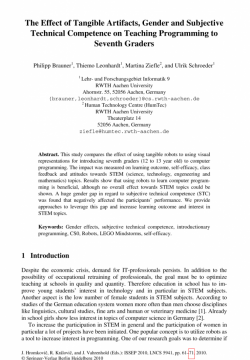
Abstract
This study compares the effect of using tangible robots to using visual representations for introducing seventh graders (12 to 13 year old) to computer programming. The impact was measured on learning outcome, self-efficacy, class feedback and attitudes towards STEM (science, technology, engeneering and mathematics) topics. Results show that using robots to learn computer program- ming is beneficial, although no overall effect towards STEM topics could be shown. A huge gender gap in regard to subjective technical competence (STC) was found that negatively affected the participants’ performance. We provide approaches to leverage this gap and increase learning outcome and interest in STEM topics.
Brauner, P., Leonhardt, T., Ziefle, M., Schroeder, U.: The Effect of Tangible Artifacts, Gender and Subjective Technical Competence on Teaching Programming to Seventh Graders. In: Hromkovic, J., Královiè, R., and Vahrenhold, J. (eds.) Proceedings of the 4th International Conference on Informatics in Secondary Schools (ISSEP 2010), LNCS 5941. pp. 61–71. Springer-Verlag Berlin Heidelberg, Zurich, Switzerland (2010).